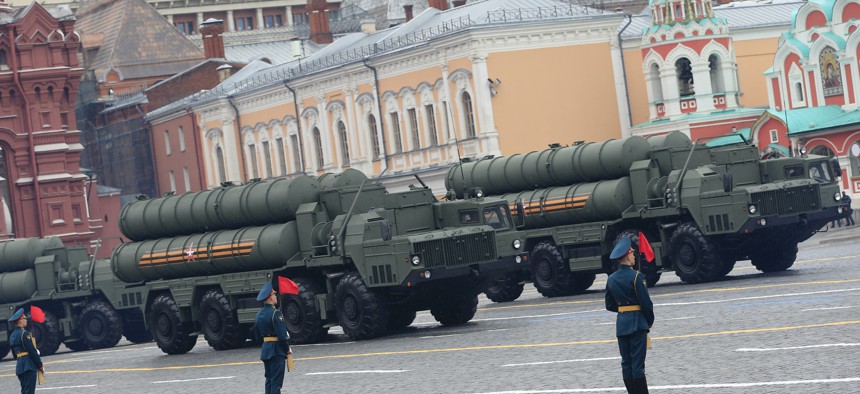
S-400 Triumph missile systems move through during 76th anniversary of the Victory Day in Red Square in Moscow, Russia on May 9, 2021. Anadolu Agency via Getty Images / Sefa Karacan
Defense Business Brief: Arms donations revelations; Russia’s SAMs; $100M hypersonic bet; and more
As Russian tanks grind their way across Ukraine, NATO and EU members are responding to Ukrainian officials’ pleas by sending arms—and the public is getting unusual glimpses into the difficulties of coordinating such transfers.
The most visible has been the failed attempt to provide Ukraine with MiG-29 fighter jets, something an EU official brought into the public view just days into the conflict. Ultimately, President Biden killed the deal, Politico reported, fearing Russia might view the move as escalatory.
The U.S. and NATO have instead preferred to rush anti-tank and anti-aircraft weapons, which the Ukrainians have used to destroy hundreds of Russian armored vehicles, tanks, and aircraft. The Wall Street Journal has reported that the U.S. is trying to get Ukraine Soviet-era S-300 interceptors that are owned by NATO members Slovakia, Bulgaria, and Greece.
There’s a certain irony here: some of the weapons that are being or may be sent to Ukraine are Russian-made. And of course, the Ukrainian military has long used Soviet weapons inherited from the country’s days as part of the Soviet Union.
Since 2018, the U.S. State Department has been giving cash to newer NATO allies that give up their Soviet weapons and buy American ones. Now that might actually happen faster with the Russia weapons heading to Ukraine.
For years, U.S. officials have warned about the sophistication and accuracy of Russian-made surface-to-air missiles. The S-400 and even newer S-500 interceptors have been a major factor in the U.S. military’s development of stealthy fighters, bombers, and cruise missiles. So it struck me as odd that non-stealth Ukrainian fighter jets have reportedly been flying missions amid Russian air defenses.
This week at the McAleese and Associates Defense Programs conference, I asked Gen. Mark Kelly, who leads the U.S. Air Force’s Air Combat Command, for his assessment of Russia’s missiles. You can see what he said here. Also, here’s more on why the U.S. is not considering sending Patriot interceptors to Ukraine.
As just mentioned, Jim McAleese’s annual conference was back, and in person, and per usual, it did not disappoint, particularly on the networking front. (It was the last conference I attended before the world shut down in March 2020 amid the coronavirus pandemic. Last year, it was held virtually.) The three service secretaries and five of the Joint Chiefs were there this year, plus a bunch of other notables. Spotted in the crowd: Patrick Shanahan, Richard Spencer, Jamie Morin, Patrick Murphy, and Dave Van Buren.
Hypersonic aircraft startup Hermeus has raised $100 million in its Series B funding round, the Georgia-based company announced this week. The funding round was led by venture capitalist Sam Altman; Peter Thiel’s Founder's Fund; and In-Q-Tel, the U.S. intelligence community’s venture capital arm. “This capital will be used to complete development of Hermeus' first aircraft Quarterhorse, begin flight services operations, and accelerate development of its next aircraft Darkhorse – an uncrewed aircraft capable of sustained hypersonic flight,” the company said. More background on Hermeus, here and here.
Lastly, the Project on Government Oversight has obtained and posted the full version of the Pentagon testing office’s annual report. It’s here. The office previously released a watered-down version of the report that removed details of the problems encountered by military weapons. Sen. Elizabeth Warren, D-Mass., has called for the Pentagon to release the full report.
 From Defense One
From Defense One
Why the US Won't Give Patriot Interceptors to Ukraine // Tara Copp and Marcus Weisgerber
The Pentagon is still hunting "alternative options" to bolster Ukraine's air defenses against Russia's brutal strikes.
US Officials Not Ready to Dismiss Russia's Anti-Aircraft Missiles, Despite Shortcomings in Ukraine // Marcus Weisgerber
The U.S. has invested heavily in expensive stealth aircraft that can evade detection from Russian interceptors.
Pentagon Could Need More Cash if Ukraine Support, NATO Border Mission Drags On // Marcus Weisgerber
Pentagon Comptroller Mike McCord also said allies are contributing more now than in the past.
Poland Offers Fighter Jets for Ukraine, But US Rejects Swap-and-Send Idea // Tara Copp and Marcus Weisgerber
Warsaw said it would send its MiG-29s to a German air base, leaving delivery to Ukraine up to the U.S. and NATO.
Putin Lost the Digital War Abroad. Will He Lose at Home? // Patrick Tucker
Its diplomatic efforts in tatters, its agencies beset by cyber vigilantes, the Russian government is still choking off the information that fuels its homegrown protest movement.
Concern Rising That Putin Could Use Nuclear Weapons // Patrick Tucker
Russian "escalate to de-escalate" doctrine suggests Putin is thinking the unthinkable.
Ukraine, Fight Your Fight—Not Their Fight // Mark Kimmitt
The Ukrainian military needs the weapons and tactics of an irregular conflict, not a conventional war.
How the Ukrainian Military Went from 'Decrepit' to Surprisingly Strong // Liam Collins
Four factors have turned the country's defensive capabilities around since Russia first invaded in 2014.




